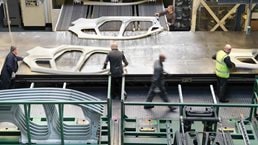Autonomous vehicles (AVs) represent a major innovation for the automotive industry, but their potential impact with respect to timing, uptake, and penetration remains hazy. While high levels of uncertainty currently surround the issue, the ultimate role that AVs could play regarding the economy, mobility, and society as a whole could be profound. In an effort to look beyond today’s rapidly changing predictions on AV penetration, we interviewed more than 30 experts across Europe, the United States, and Asia and combined these findings with our insights to arrive at ten thought-provoking potential implications of self-driving cars.
The widespread use of AVs could profoundly affect a variety of industry sectors. To explore these implications in depth, we focused on three time horizons of AV diffusion: before such vehicles are commercially available to individual buyers, when they are in the early stage of adoption, and when they become the primary means of transport (exhibit).

Era one: AVs not yet available to consumers
1. Industrial fleets lead the way.
While it’s unlikely that any on-road vehicles will feature “fully autonomous” drive technology in the short term (for instance, by 2020–22), AVs are already a reality in selected applications that feature controlled environments, such as mining and farming. In these cases, the restricted nature of operations and the possibility to operate on private roads facilitate adoption. Some of the benefits of autonomy in these fields include labor-cost savings and the reduction in carbon dioxide (CO2) emissions through optimized driving (shown to cut emissions by as much as 60 percent). Other adjacent equipment applications—for example, in the construction and warehousing sectors—should see the next AV applications for vehicles such as excavators, forklifts, and loaders.
In the medium term (through 2040), on-highway trucks will likely be the first vehicles to feature the full technology on public roads. Prototypes already exist, and companies are currently developing the software algorithms needed to handle complex driving situations. Long-term automated commercial fleets might include vehicles for parcel delivery as well as automated drones, which multiple players are already field-testing.
2. Car OEMs face a decision.
Automakers worldwide will likely define and communicate their strategic position on AVs in the next two to three years. We have identified four strategic stances they can assume when introducing their autonomous-vehicle offerings:
- Premium incumbents. Established premium players with extensive customer bases and strong technical and commercial legacies will probably take an incremental approach to AVs. This likely means they will gradually introduce increasing levels of advanced driver-assistance systems (ADAS) in their vehicles.
- Attackers. New industry players developing “radically new” vehicle architectures—such as high-tech giants, first-tier suppliers, and mobility operators—will focus on the “accessible mobility” consumer segment to capture volumes quickly and sustain ancillary business models.
- Fast followers. These OEMs have significant technical and commercial legacies. They will most likely invest in AV research and then wait for the vehicle-level costs of the core technologies to drop while penetration in the premium segments grows.
- Late entrants/nonadopters. As the name implies, these automakers will avoid entering the AV market in the short to medium term.

Would you like to learn more about our Automotive & Assembly Practice?
3. New mobility models emerge.
While OEMs are developing autonomous vehicles, a variety of other transport-mobility innovations are already hitting the road. Many of these take the form of pay-per-use models such as car sharing, carpooling, “e-hailing” taxi alternatives, and peer-to-peer car rentals. These plays are attracting investments and seeing impressive growth rates. The e-hailing model in particular has experienced strong growth given both annual investment funding and market penetration.
Era two: AVs enter the early-adoption phase
4. The car-service landscape changes.
The proliferation of AVs could represent an opportunity for car OEMs. As of 2014, for example, roughly 80 percent of the car-service shops in Germany were “independent” from OEMs. Given the safety-critical nature of AV technologies, customers might strongly prefer strict adherence to OEM service processes and the use of original service equipment when it comes to maintaining and repairing AV systems. This could imply a disadvantaged position for independent service providers unable to afford AV-maintenance systems. Furthermore, our research shows that nearly 60 percent of customers would follow their smart cars’ recommendations for service locations. Beyond the benefits of a bigger after-sales revenue stream, OEMs will have a strong incentive to service these vehicles, since regulators could ultimately force them to take on the greatest portion of the responsibility and risk associated with crashes caused by AV technical failures.
5. Car insurers might shift their business model.
Car insurers have always provided consumer coverage in the event of accidents caused by human error. With driverless vehicles, auto insurers might shift the core of their business model, focusing mainly on insuring car manufacturers from liabilities from technical failure of their AVs, as opposed to protecting private customers from risks associated with human error in accidents. This change could transform the insurance industry from its current focus on millions of private consumers to one that involves a few OEMs and infrastructure operators, similar to insurance for cruise lines and shipping companies.
6. Companies could reshape their supply chains.
AV technologies could help to optimize the industry supply chains and logistics operations of the future, as players employ automation to increase efficiency and flexibility. AVs in combination with smart technologies could reduce labor costs while boosting equipment and facility productivity. What’s more, a fully automated and lean supply chain can help reduce load sizes and stocks by leveraging smart distribution technologies and smaller AVs.
Era three: AVs go mainstream
7. Drivers have more time for everything.
AVs could free as much as 50 minutes a day for users, who will be able to spend traveling time working, relaxing, or accessing entertainment. The time saved by commuters every day might add up globally to a mind-blowing one billion hours—equivalent to twice the time it took to build the Great Pyramid of Giza. It could also create a large pool of value, potentially generating global digital-media revenues of €5 billion per year for every additional minute people spend on the mobile Internet while in a car.
8. Parking becomes easier.
AVs could change the mobility behavior of consumers, potentially reducing the need for parking space in the United States by more than 5.7 billion square meters. Multiple factors would contribute to the reduction in parking infrastructure. For example, self-parking AVs do not require open-door space for dropping off passengers when parked, allowing them to occupy parking spaces that are 15 percent tighter.
9. Accident rates drop.
By midcentury, the penetration of AVs and other ADAS could ultimately cause vehicle crashes in the United States to fall from second to ninth place in terms of their lethality ranking among accident types. Today, car crashes have an enormous impact on the US economy. For every person killed in a motor-vehicle accident, 8 are hospitalized, and 100 are treated and released from emergency rooms. The overall annual cost of roadway crashes to the US economy was $212 billion in 2012. Taking that year as an example, advanced ADAS and AVs reducing accidents by up to 90 percent would have potentially saved about $190 billion.
10. AVs accelerate robotics development for consumer applications.
The broad penetration of AVs will likely accelerate the development of robotics for consumer applications (including humanoid robots), since the two share many technologies. These include remote advanced sensing, hyperprecise positioning/GPS, image recognition, and advanced artificial intelligence. In addition to sharing technology, AVs and robots could benefit from using the same infrastructure, including recharging stations, service centers, and machine-to-machine communication networks. These commonalities might push multiple players to invest in both applications, as already shown by the significant investments in robotics made by selected automakers and high-tech players.
In addition to transforming the automotive industry, the rise of autonomous vehicles will likely have a profound impact on society. The ten developments described here provide a snapshot over the wide spectrum of possible outcomes linked to the increasing penetration of AVs in the market, offering industry leaders a look forward at this evolving landscape as it unfolds before them. Defining how to shape this landscape effectively represents a significant strategic challenge for the industry and regulatory authorities in the coming years.


